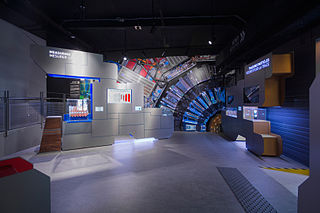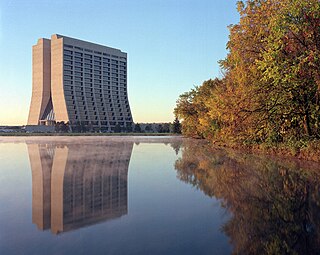
The European Organization for Nuclear Research, known as CERN, is an intergovernmental organization that operates the largest particle physics laboratory in the world. Established in 1954, it is based in Meyrin, western suburb of Geneva, on the France–Switzerland border. It comprises 23 member states. Israel, admitted in 2013, is the only non-European full member. CERN is an official United Nations General Assembly observer.

DESY, short for Deutsches Elektronen-Synchrotron, is a national research centre for fundamental science located in Hamburg and Zeuthen near Berlin in Germany. It operates particle accelerators used to investigate the structure, dynamics and function of matter, and conducts a broad spectrum of interdisciplinary scientific research in four main areas: particle and high energy physics; photon science; astroparticle physics; and the development, construction and operation of particle accelerators. Its name refers to its first project, an electron synchrotron. DESY is publicly financed by the Federal Republic of Germany and the Federal States of Hamburg and Brandenburg and is a member of the Helmholtz Association.

The Compact Muon Solenoid (CMS) experiment is one of two large general-purpose particle physics detectors built on the Large Hadron Collider (LHC) at CERN in Switzerland and France. The goal of the CMS experiment is to investigate a wide range of physics, including the search for the Higgs boson, extra dimensions, and particles that could make up dark matter.

The Large Hadron Collider (LHC) is the world's largest and highest-energy particle collider. It was built by the European Organization for Nuclear Research (CERN) between 1998 and 2008 in collaboration with over 10,000 scientists and hundreds of universities and laboratories across more than 100 countries. It lies in a tunnel 27 kilometres (17 mi) in circumference and as deep as 175 metres (574 ft) beneath the France–Switzerland border near Geneva.

ATLAS is the largest general-purpose particle detector experiment at the Large Hadron Collider (LHC), a particle accelerator at CERN in Switzerland. The experiment is designed to take advantage of the unprecedented energy available at the LHC and observe phenomena that involve highly massive particles which were not observable using earlier lower-energy accelerators. ATLAS was one of the two LHC experiments involved in the discovery of the Higgs boson in July 2012. It was also designed to search for evidence of theories of particle physics beyond the Standard Model.

The Large Electron–Positron Collider (LEP) was one of the largest particle accelerators ever constructed. It was built at CERN, a multi-national centre for research in nuclear and particle physics near Geneva, Switzerland.

The Budker Institute of Nuclear Physics (BINP) is one of the major centres of advanced study of nuclear physics in Russia. It is located in the Siberian town Akademgorodok, on Academician Lavrentiev Avenue. The institute was founded by Gersh Budker in 1959. Following his death in 1977, the institute was renamed in honour of Budker.

Microcosm or CERN Museum was an interactive exhibition presenting the work of the CERN particle physics laboratory and its flagship accelerator the Large Hadron Collider (LHC). It first opened to the public in 1990 and closed permanently in September 2022, to be replaced by the Science Gateway in 2023. The final version of the exhibition opened in January 2016, developed by CERN in collaboration with Spanish design team Indissoluble.

The LHCb experiment is a particle physics detector experiment collecting data at the Large Hadron Collider at CERN. LHCb is a specialized b-physics experiment, designed primarily to measure the parameters of CP violation in the interactions of b-hadrons. Such studies can help to explain the matter-antimatter asymmetry of the Universe. The detector is also able to perform measurements of production cross sections, exotic hadron spectroscopy, charm physics and electroweak physics in the forward region. The LHCb collaboration, who built, operate and analyse data from the experiment, is composed of approximately 1650 people from 98 scientific institutes, representing 22 countries. Vincenzo Vagnoni succeeded on July 1, 2023 as spokesperson for the collaboration from Chris Parkes. The experiment is located at point 8 on the LHC tunnel close to Ferney-Voltaire, France just over the border from Geneva. The (small) MoEDAL experiment shares the same cavern.

CERN openlab is a collaboration between CERN and industrial partners to develop new knowledge in Information and Communication Technologies through the evaluation of advanced tools and joint research to be used by the worldwide community of scientists working at the Large Hadron Collider.

The Collider Detector at Fermilab (CDF) experimental collaboration studies high energy particle collisions from the Tevatron, the world's former highest-energy particle accelerator. The goal is to discover the identity and properties of the particles that make up the universe and to understand the forces and interactions between those particles.

Maria Spiropulu is a Greek particle physicist. She is the Shang-Yi Ch'en Professor of Physics at the California Institute of Technology.

Roy F. Schwitters was an American physicist, professor of physics at Harvard, Stanford, and finally the University of Texas at Austin. He was also director of the Superconducting Super Collider between 1989 and 1993.
The Roman pot is the name of a technique used in accelerator physics. Named after its implementation by the CERN-Rome collaboration in the early 1970s, it is an important tool to measure the total cross section of two particle beams in a collider. They are called pots because the detectors are housed in cylindrical vessels. The first generation of Roman pots was purpose-built by the CERN Central Workshops and used in the measurement of the total cross-section of proton-proton inter-actions in the ISR.

The LHCf is a special-purpose Large Hadron Collider experiment for astroparticle physics, and one of nine detectors in the LHC accelerator at CERN. LHCf is designed to study the particles generated in the forward region of collisions, those almost directly in line with the colliding proton beams.
ALEPH was a particle detector at the Large Electron-Positron collider (LEP) at CERN. It was designed to explore the physics predicted by the Standard Model and to search for physics beyond it.
OPAL was one of the major experiments at CERN's Large Electron–Positron Collider. OPAL studied particles and their interactions by collecting and analysing electron-positron collisions. There were over three-hundred physicists from 32 institutions involved in the collaboration.

The Worldwide LHC Computing Grid (WLCG), formerly the LHC Computing Grid (LCG), is an international collaborative project that consists of a grid-based computer network infrastructure incorporating over 170 computing centers in 42 countries, as of 2017. It was designed by CERN to handle the prodigious volume of data produced by Large Hadron Collider (LHC) experiments.

The Future Circular Collider (FCC) is a proposed particle accelerator with an energy significantly above that of previous circular colliders, such as the Super Proton Synchrotron, the Tevatron, and the Large Hadron Collider (LHC). The FCC project is considering three scenarios for collision types: FCC-hh, for hadron-hadron collisions, including proton-proton and heavy ion collisions, FCC-ee, for electron-positron collisions, and FCC-eh, for electron-hadron collisions.

Sheldon Leslie Stone was a distinguished professor of physics at Syracuse University. He is best known for his work in experimental elementary particle physics, the Large Hadron Collider beauty experiment (LHCb), and B decays. He made significant contributions in the areas of data analysis, LHCb detector design and construction, and phenomenology.













